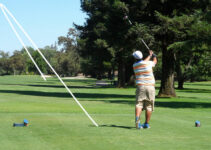Golfstead is reader-supported. When you buy through links on the site, we may earn an affiliate commission at no extra cost to you. Our affiliations include, but are not limited to, the eBay Partner Network and Amazon Associates.

The grip is one of the most important components of the golf swing, and it’s one of the first things you should make sure you get right before you even think about anything else.
Many problems golfers (amateurs and professionals alike) deal with can be partially or completely solved with a straightforward grip adjustment. Surprised?
Some might be, but it speaks to the fact that playing good golf doesn’t have to be complicated.
This article will teach you the correct ways to grip a golf club, so you can build a rock solid foundation for playing good golf.
The Three Types Of Grips
In golf, there are three grip styles that are generally accepted to be “correct” in the sense that they stand the best chance of maximizing the consistency of any one golfer.
This is not to say anything that deviates from this is bad; there are many skilled golfers that have success with very unorthodox grips, but this is not something that will be explored in the article.
The three main (and effective) types of grips are the ten-finger grip, overlap grip, and interlocking grip.
1. Ten-Finger Grip
Having a close resemblance to the grip used in baseball, this is also called the baseball grip.
It is perhaps the most basic grip used in golf and probably the best to start off with if you are a beginner because it’s quite easy to remember.
Here’s a step-by-step guide on adopting this grip assuming you are a right-handed golfer (if you’re left-handed, it’s the inverse):
- Place your left hand at the very end of the golf club (opposite the clubhead).
- Close your fingers in such a way that the club is primarily in contact with your fingers as opposed to the palm.
- Point your thumb directly towards the club head.
- Place your right hand just below your left hand so that your right pinky is touching your left index finger.
- When you close your right hand, your left thumb should be touching your right palm, and your right thumb should be pointing slightly to the left.
For many people, the ten-finger grip feels the most natural out of all the grip styles, and because all ten fingers are making contact with the club, you have the potential to generate a lot of power in the swing.
2. Overlap Grip
Also known as the Vardon Grip (popularized by golfer Henry Vardon), it can be argued that the overlap grip is the preferred grip among professionals.
Due to requiring a stronger finger contact than the ten-finger grip, the overlap offers better stability.
- Start with a ten-finger grip.
- Instead of resting your right pinky above the left index finger, bring it over the left hand so that it rests between your index and middle fingers.
This is my personally preferred grip style that is most comfortable and gives me the best results.
The overlap grip tends to work well for people with larger hands. It unifies the movement of both wrists but also allows them a certain degree of freedom.
3. Interlocking Grip
The interlocking grip offers the most stability. Because it actually involves a lock-type position of the fingers, the idea is that it helps keep the club in a steady position throughout the swing.
This grip is often ideal for people with small hands.
- Start with a ten-finger grip.
- Place your right pinky between your left index and middle fingers; similarly, place your left index between your right pinky and ring fingers.
The interlocking grip allows the hands to work as one unit, and because of the security of the interlocking fingers, you’ll find that you don’t need to hold the grip so tightly in order to maintain control of the club.
However, what I have found is that the interlocking grip can stretch the pinky and give some golfers finger pain. In this case, the overlap grip is often a great alternative.
It’s worth noting that Tiger Woods, Jack Nicklaus and Rory McIlroy have all used the interlocking grip.
For a visual guide, see PGA Golf Professional Andy Proudman demonstrate in the video below:
Grip Strength
In addition to the grip styles above, there are also types related to hand position known as weak, neutral and strong grips.
Contrary to being referred to as “grip strength”, this doesn’t actually refer to how firmly or tightly you grip the club. Rather, it simply has to do with the rotational position of your hands on the shaft.
Weak, neutral and strong grips are typically associated with fade, straight and draw ball flights, respectively. Swing problems such as frequently slicing or hooking the ball are often caused by grips that are overly weak or overly strong.
The grip that most golfers start out with is the neutral grip, which is adjusted into a weak or strong position as necessary.
It is completely possible to use a neutral grip only and be a very successful golfer, but in the event you want to try something a little different, achieving a weak or strong grip is simply a matter of rotating your hands in unison left or right from a neutral grip position.
1. The Neutral Grip
If there is a true standard grip in golf, the neutral grip (sometimes called the modern grip) would be it.
A neutral grip coupled with a proper golf swing will tend to produce a square clubface relative to the swing path, and hence a straight ball flight.
Procedure
To achieve the neutral grip, the right-handed golfer should do the following (the roles of the right and left hands reverse for a left-handed golfer):
Start by holding the club with the clubhead resting on the ground and pointing directly ahead of you. Grip the club underhand with your left hand just above the halfway point of the grip such that:
- your thumb is resting on top of the shaft.
- you can see two knuckles from the address position.
- the crease between your left thumb and your left index finger is pointing roughly at the middle-right side of your chest.
Then, grip the club with your right hand such that:
- your right thumb rests on top of the shaft (farther down than your left thumb), and all fingers on your right hand except the pinky are touching the grip.
- the left thumb rests up against the meaty part of your right palm.
- you can, at most, see the knuckle of your right index finger.
- the crease between your right thumb and right index finger is pointing roughly at the middle-left side of your chest.
With your right pinky touching your left hand, you can adopt the overlap, interlocking or ten-finger grip as desired.
2. The Weak Grip
A weak grip, so named because of the way it limits wrist action, will tend to produce an open clubface relative to the swing path and hence a fade or slice shot shape.
Due to the effect opening the clubface has on loft, the weak grip makes it easier to hit higher trajectory shots with more spin.
It isn’t a particularly comfortable hand position for most golfers; unless you’re battling a hook or you want to fade the ball, the weak grip usually isn’t a good choice.
Procedure
From the neutral grip position (see above), rotate your hands and the shaft together to the left at least until you can see the knuckles of the index finger and middle finger of your right hand.
Make sure that you make this rotation without rotating the club itself, as this will close the clubface.
Pros who have used the weak grip include Ben Hogan, Corey Pavin, and Curtis Strange.
3. The Strong Grip
A strong grip will tend to produce a closed clubface relative to the swing path and hence a draw shot shape.
A strong grip allows for more wrist action, makes it easier to hit de-lofted shots, and can often help generate additional clubhead speed.
Golfers who struggle with slices or intentionally want to draw the ball should try this grip.
Procedure
From the neutral grip position, rotate your hands and the shaft together to the right until you can see at least two of the knuckles of your left hand — your index and middle fingers.
Make sure that you make this rotation without rotating the club itself, as this will open the clubface.
Pros who have used the strong grip include Paul Azinger, Fred Couples, and Dustin Johnson.
Cleaning Your Golf Grips

Grip cleaning and maintenance is often overlooked. It’s extremely beneficial to do a simple clean of your grips at least a couple of times a month, although it depends on how much you play.
Clean grips will restore tack, prevent hand slippage and increase comfort, and this could be the difference between an amazing round and a terrible one.
An easy, quick and effective way to clean your golf grips is to use a cloth wetted with a mixture of water and mild detergent.
For an even more thorough cleaning, you can dip a soft-bristle brush into warm soapy water and scrub the grip on all sides. Then, rinse the soap off the grip and use a towel to pat it dry.
Conclusion
Using the right grip when golfing is important, not only to have a more powerful, accurate, comfortable and consistent swing, but also to avoid a very frustrating slice, which is often caused by a bad grip.
Settling into a grip that works best for you may take time and effort, but it will certainly be worth having one less thing to worry about so that you can place more focus on other aspects of the swing.
If you want to see serious improvement in your swing and game, check this out:
Alternatively, you can check out our complete guide on how to swing a golf club.
Thanks for reading this guide. Which grip style do you use? Let us know in the comments below!





So the trick seems to be to keep a relatively relaxed hand when holding the club if I understand correctly?
You definitely don’t want to grip the club too tightly (or too loosely, for that matter). You should apply a pressure that feels comfortable, with little to no tension in your hands and forearms, and also that allows you to have good control over the club throughout the swing.
I’m sorry, but looking at your pintrest picture you have the weak and strong grip backwards
I don’t actually. If you do a simple Google image search for golf grips (for a right-handed player) you’ll see that I have it correct. I will admit though that it can be unintuitive for a lot of people — it was for me when I was learning.
never mind, was looking at it wrong. you got it right, lol